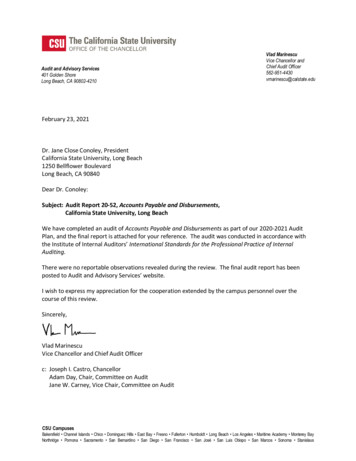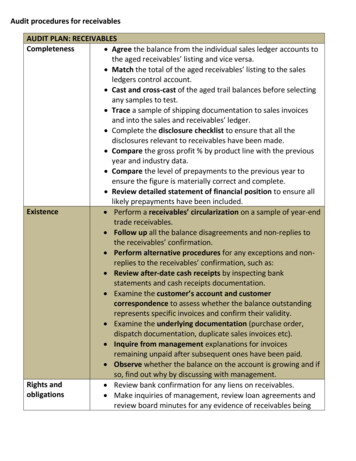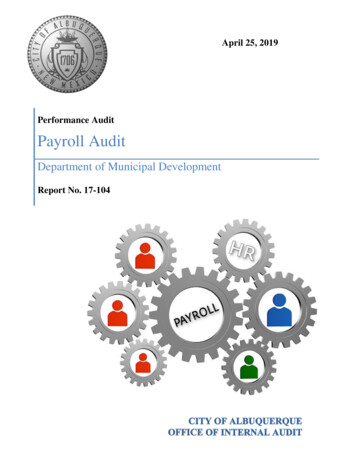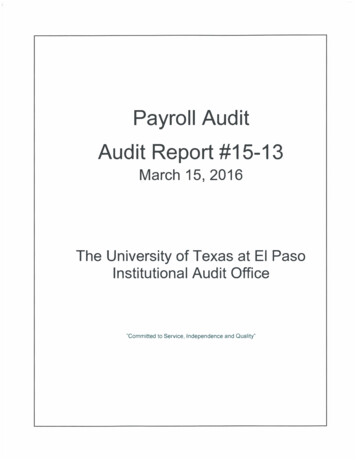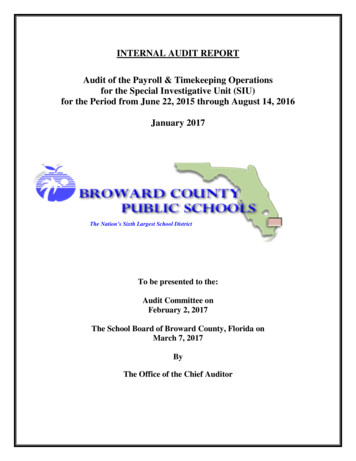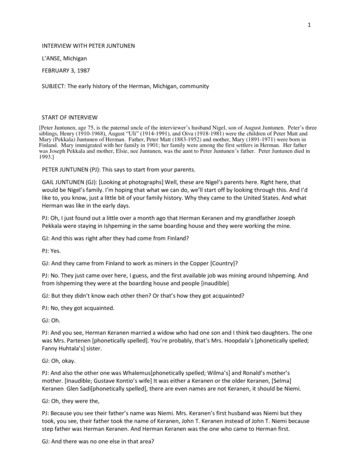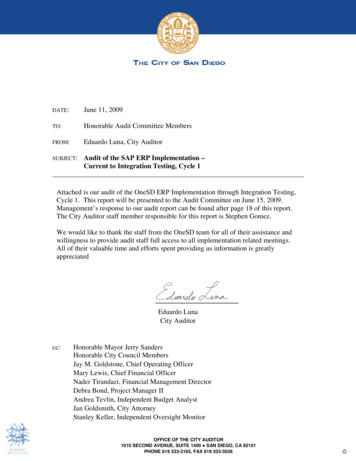
Transcription
Page 1Honorable Members of the Audit CommitteeMay 11, 2009DATE:June 11, 2009TO:Honorable Audit Committee MembersFROM:Eduardo Luna, City AuditorSUBJECT:Audit of the SAP ERP Implementation –Current to Integration Testing, Cycle 1Attached is our audit of the OneSD ERP Implementation through Integration Testing,Cycle 1. This report will be presented to the Audit Committee on June 15, 2009.Management’s response to our audit report can be found after page 18 of this report.The City Auditor staff member responsible for this report is Stephen Gomez.We would like to thank the staff from the OneSD team for all of their assistance andwillingness to provide audit staff full access to all implementation related meetings.All of their valuable time and efforts spent providing us information is greatlyappreciatedEduardo LunaCity Auditorcc:Honorable Mayor Jerry SandersHonorable City Council MembersJay M. Goldstone, Chief Operating OfficerMary Lewis, Chief Financial OfficerNader Tirandazi, Financial Management DirectorDebra Bond, Project Manager IIAndrea Tevlin, Independent Budget AnalystJan Goldsmith, City AttorneyStanley Keller, Independent Oversight MonitorOFFICE OF THE CITY AUDITOR1010 SECOND AVENUE, SUITE 1400 SAN DIEGO, CA 92101PHONE 619 533-3165, FAX 619 533-3036
Audit of tine SAP ERP(llplementaJionCurrent to Integratipo Te ting,. Cycle1
Kroll Report RemediationsThe 2006 Kroll report identified significant Control Weaknesses that the City has acceptedand agreed to remediate. The Enterprise Resource Planning (ERP) system is central to theremediation of many of the larger Control Weaknesses identified. 47 Million for Project ImplementationThe implementation is a high cost,cost high impact,impact and high profile project which results inhigh risk (The 47 Million does not include the cost of debt services)Impacts the manner in which core city departments will perform business2
As a result of the identified reasons for performing an Audit of the ERPImplementation and in accordance with the Office of the City Auditor’s Fiscal Year2009 Audit Work Plan, we are conducting an audit of the City’s SAP EnterpriseResource Planning (ERP) Implementation. The Audit work plan defines the keyobjectives of this review as:1)Determine if the City’s key financial activities are being adequatelyreviewed and documented prior to the new system implementation toensure key financial processes are properly addressed by the newsystem2)Determine if the system was adequately tested prior to implementation3
This update focuses on the timeframe from December 2008 to April 2009This Audit has been in process from October to Present. However, due to significantchanges in the project management and approach, this update covers thetimeframe from December 2008 to April 2009, from the point SAP became theimplementer for the project to the completion of the first cycle of IntegrationTesting for phases one and two4
We are conducting this performance audit in accordance withgenerally accepted government auditing standards, Those standards require that we plan and perform the audit toobtain sufficient, appropriate evidence to provide areasonable basis for our findings and conclusions based onour audit objectives. We believe that the evidence obtained provides a reasonablebasis for our findings and conclusions based on our auditobjectives55
Risk Categorization (Based on Potential Project Impact)Risk is categorized by the level of potential impact to the implementation of the ERPsystem and the services the system is designed to provide when implementedAudit Project Participation & Risk EvaluationThe Auditor attends weekly technical and Project Advisory Committee meetings tohelp gauge what areas of the project are being adequately addressed, and whatareas may not sufficiently be on the project team’s “radar”Risk Approach PriorityThe Auditor proceeds with the audit plan unless a higher risk area becomes evident.When this occurs, the higher risk item is addressed first6
This is not a typical Audit, in that the issues are identified prior to impacting the project,andd management has an opportuniity to remedidiate thhe issue beforefit couldld becomebone.Audit identifies items that would become issues if not addressed To support this objective, we are approaching the audit using a Risk Based Approach tiedto the Project Schedule to identify issues early so they can be corrected prior to go‐live We will not be able to look at everything during the implementation,implementation but will complete theERP audit plan as we are able, after higher risk items have been addressed. The auditor reviews a component of a Category, and once he gains sufficient confidencethat risks are being addressed he will: Document the current status Save the evidence Complete the section after the Higher Risk items are addressedWe have scoped the above ten categories as high risk areas to review during theimplementation7
Identified Risk CategoriesPrimary RHiew Categories6) SAP Se :IJrllyAddresses areas such as:Gov."nln g:g ::::: RO'lleei ! 'ng,Process Co1'0 ""'''''';'01111'01.,Roil-oulprior 10 goilve, post go-live .uppor! and roll-out8) Cut-Over'\\ Stabilizalion9)T''''lnIM Roll- lut Methodology, KA" At,.,.Addressed10) DemlsingSyslemsH,stollcal Data Storage,Access,Phas" Out8
Issue resolution at the frontline staff level when possibleWe initially approach each potential issue with the appropriate section team leadHigh risk issues, based on potential impact to project, are brought tomanagement’s attentionIf the issue is considered a high risk, and not resolvable at the lead level, the auditordiscusses the issue with the Project DirectorEscalated high risk issue communicationHigh Risk Issues are communicated defining the Condition, Criteria, Cause, andEffect as well as audit’s recommendationIssue remediation processWe then meet with management to make sure identified audit concerns aresufficiently remediated or mitigated9
Identified IssuesWhile performing audit’s review up to Integration Testing, Cycle 1 – Audit has identified thefollowing issues and communicated the risk of each item to the project management teamIssue FocusWe have attempted to find the “core” of each issue, and focus on the cause of the issuethat needs to be addressed. This allows for more effective and timely remediation.10
We will go into more detail for each issue in the following slides. Please note that theseissues are current to April, and that the issues have been in the process of remediationafter this reporting period.11
The AR implementation as defined within the Statement of Work (SOW) does notmeet the business requirements of the CityThe current Statement of Work (SOW) states that “AR will be implemented on apilot basis for one CoSD department (department to be determined) six monthsafter the initial Go‐ Live”This presents an incomplete Accounts Receivable solution to be addressed at a laterdateIf not corrected, the risks include: Potential failure to meet initial ERP objectives as defined in the project charter Future costs to remediate Additional complications due to running the legacy system in parallelAR Amendment to SOW is in process to implement a complete solutionThe City, SAP and Audit agree that implementing AR in this manner will not besufficient to meet the City’s needs. Therefore, project management is currentlyworking with SAP to amend the SOW for implementation of a Core AR module toreplace the current AR system12
The Statement of Work (SOW) does not clearly define in sufficient detail the expecteddeliverable productIf not corrected, the risks include: Missed or inadequate deliverable items Delays while mapping items to the SOW after the fact The mandatory acceptance of a deliverable not reviewed and approved within the fivebusiness day allowance defined in the Statement of WorkManagement has provided a deliverable expectation document for audit’s reviewThe Project Management Team has created a deliverable expectation document to definethe content of each future deliverable. The auditor is in the process of reviewing thedocument.13
A comprehensive, unified, and concise Security Strategy has not been providedAudit has reviewed the security planning information provided and has found that the teamis missing components for a comprehensive, unified, and concise strategy for theimplementation of Security within the SAP implementationIf not corrected, the risks include: Additional time and resources required to rework Security aspects during theimplementation An inadequate and incomplete security solution Insufficient and ineffective use of the security features provided within SAP A reactive and segmented approach to security implementation and managementManagement is in the process of addressing the recommended areas in the StrategydocumentManagement is in the process of completing this missing components for a comprehensive,unified and concise SAP security strategy that will map to the City’s strategy. The currentblueprint document will be expanded to include the recommended areas and completesecurity strategy.14
An adequate SAP Security Policy does not existCurrently, the Security team has drafted a “Security Guideline” document thatdescribes the general principles of security, but is missing components to addressseveral primary areas of security with sufficient detail to configure the systemsecurity according to defined City requirements.If not corrected, the risks include: Missed Controls//Security Requirements designed into the system Inadequate System Security Non‐compliance with City Security Standards Additional specialist/contractor hours spent correcting non‐compliant securityconfigurations, ultimately resulting in additional costsThe OneSD Team is in the process of creating a Security Policy addressing therecommended key areas of securityManagement has provided a high level remediation plan and is in the process of addressingthe missing components for a Security Policy that will tie into the overall SAP SecurityStrategy and map back to the City Security Policy.15
A documented global strategic plan and methodology does not exist to address themitigation of Segregation of Duties (SOD) conflictsIf not corrected, the risks include: A wide spectrum of mitigation methodologies without uniform resolutions Additional overhead required to manage and track SOD conflicts, resulting in additionalcosts Overly complex methods of managing conflicts Inability to effectively manage conflicts Inadequately controlled conflict mitigationThe OneSD Team has provided a draft SOD Mitigation Strategy for Audit’s reviewAudit is in the process of reviewing the SOD Mitigation Strategy16
Master Service Agreement (MSA) currently does not define Service LevelAgreement (SLA) criteria & requirements to ensure City required service levels aremetSLA’s for approved years have been consistently signed late in the Fiscal Year. SLA’sdefine criteria for SDDPC’s management of contracts as well as support levelsincluding those of SAP. This further impacts the project as Future SLA’s will defineservice levels for SAP Technical Support.If not corrected, the risks include: Untimely Service Level Agreements (defining expected Service Levels such as SAPHelp Desk response time) Inability to mitigate risk of knowledge loss and retraining, specifically regarding SAPknowledge transfer from the implementationdequate governance over IT services providdedd to thhe City InadManagement has a remediation plan and is in the initial stagesThe Office of the CIO and SDDPC are in the initial stages of updating the MSA tomore adequately meet the City’s & DPC’s requirements. Expected timeframe forthe new MSA will be Fall 2009.17
18
City\OneSD Response to Auditof SAP ERP SystemJune 15, 2009ader Tiranda zi Financial Management Director andInterim Chief lnfonnation OfficerDebra Bond, OneSD Project DirectorHoward Stapleton, Deputy Director Office of the CIOBackground In January 2009, Internal Audit began participation inOneSD to give input to tbe implementation. OneSD provided and continues to provide unrestrictedaccess to IntenlaI Audit - documents, shared networkdtives, systeln test environlnents, team lead meetings, andother meetings. Inte111a1 Audit has had the unique opportunity to observethis high-intensity, large-scale project first hand, and inreal-time.2
Change of Scope for AccountsReceivable (AR) sow change planned for July based on roadlnap analysisfor implenlenting AR for General Fund and EnterpriseDepartments. Analysis will evaluate the entire City AR implementation.Impacts include Water Department billing. Results of the analysis \vill detennine the AR SOW detailand the City design and implementation of AR.Deliverable Definitions The SAP Statelnent of Work includes the list of projectmilestone deliverables. In February 2009, the OneSD PMO identified deliverablesthat required further description. The OneSD PMO added descriptive infornlation to aI1deliverables for clarification. onlpleted.4
Security Strategy and Policy According to SAP in1plenlentation 111ethodology, the Policy andStrategy docUll1ents would not be expected to be in a final state at thetime Internal Audit identified their concerns. Internal Audit reviewed a work-in-progress and OneSD communicatedthat the plan was a draft, not yet completed. COlllpliance and integration w'ith the City's enterprise IT securitypolicies and standards is part of the OneSD implelnentation strategy. The OneSD team planned approach is to finalize the documents tocontain all required lnfo1111ation.5Role Mapping, Separation of Duties (SOD)Mitigation Strategy The OneSD security team has docUlnented process flows for assignnlent ofroles and mitigation of separation of duties conflicts both pre and post go-live.These have been provided to Internal Audit. The City considers internal controls, role mapping, and SOD mitigation ofctitical inlportance. The GRC (Govelnance Risk Compliance) module of SAP is beinginlplen1ented to identify, ren1ediate. and ll1onitor SOD. RSM McGladrey, an outside consultant is reviewing the internal controlinlpletnentation.-A ttending meetingsReviewing documentationand process flows6
Master Services Agreell1ent (MSA) This is a Citywide item not specific to OneSD. Well defined service levels and performance Inetrics willhelp ensure the effective Inanagelnent of the ERP systema fter go-live. In process of being cOlnpleted by the Office of the CIO.7Milestone Deliverables Categorized as ren1ediated. Milestone deliverables have been fonnaJly accepted throughMarch.8
SLA Governing SAP Contract Categorized as relnediated. The Citywide SLA between the City and SOOPC wasapproved in March 2009.9Summary Remediated-- Milestone Deliverables-SLA Governing SAP Contract COlnpleted Pending Review of Internal Audit- Deliverable Definitions- Role Mapping SOD In Progress- Change of Scope for AR: July-Security Strategy and Policy: July-Master Services Agreelnent (MSA): Fall 2009]0
THE CITY OF SAN DIEGOMEMORANDUMDATE:June 12, 2009TO::d::: : : :;F:Ua:: :IOfficer I JdlV Nader Tirandazi, Financial Manageme{;; ire tg and IntenFROM:ICIODebra Bond, OneSD Project DirectoSUBJECT:OneSD Audit ResponsesIn January 2009, the OneSD team welcomed Internal Audit's request to audit the project in aproactive manner to provide input on the implementation process. It did not constitute atraditional audit, but rather an opportunity for Internal Audit and the OneSD team to workcollaboratively to review the ongoing status of internal controls being implemented in SAP.Since that time, the OneSD team has provided unrestricted access to documents and data, sharednetwork folders, SAP landscapes for development and test, as well as participation in weeklyteam lead and integration meetings where issues are identified and discussed in a candid andopen environment. Internal Audit has had the unique opportunity to observe this high-intensity,large-scale project first hand, and in real-time.'Response to Report Item #1 - Change of Scope to Accounts Receivable (AR):Tills item was initial1y raised in January and discussed by the OneSD team 4uring a series ofmeetings in February and March. The implementation as currently scoped in the SAP Statementof Work (SOW) indicates that AR will be implemented on a pilot basis for one department. It isthe City's intent to modify the SOW to indicate that the AR implementation will be designed toreplace the City s general accounts receivable system, called ARIS. The City is awaitinginfonnation from an analysis to be done in June, which will define the appropriate SAPconfigurations to be used for the AR implementation, and therefore will be included in therevised SOW. There is not anticipated to be any project delay due to the timing of the SOWmodification.
Page 2Eduardo Luna, City AuditorJune 12, 2009Response to Report Item #2 -Deliverable Definitions:In February, at the request of the OneSD Project Management Office (PMO), SAP and the CityOneSD team created a document describing each outstanding deliverable as outlined in theStatement of Work. The identification of this item came about based on the challengesdiscovered by the OneSD team in documenting the results of work performed within the contextof one of the deliverable titles listed in Exhibit 6. The OneSD City and SAP team agreed uponand documented the content of each future deliverable.Response to Report Item #3 - SAP Security Implementation Strategy and Response toReport Item #4 - SAP Security Policy:During an April meeting with OneSD and Internal Audit, the draft OneSD security documentswere reviewed and it was determined that while the documents were substantially complete, theyneeded to be reworked into one Strategy document and one Policy document. It wasacknowledged that the OneSD document reviewed by Internal Audit were draft versions,planned to be completed iteratively as the project progressed.The OneSD team has been working and continues to work with the Department of IT on thepolicies and strategies to ensure conlpliance with citywide security policy and standards. OneSDand the Department of IT are also ensuring that documented SAP policies and standards link tothe City'S enterprise IT policies and standards in the areas of user provisioning, security, andsystem -to-system interfaces.The OneSD team worked toward finalizing documents that would contain the additionalinformation identified by Internal Audit. It is noteworthy, from an SAP implementationmethodology perspective, that the Policy and Strategy documents would not have normally beenin a final state at the time Internal Audit identified their concerns. It is from a timing perspectivethat the PMO does not agree with this item. The OneSD team is confident that the concernsraised by Internal Audit will be addressed in the final security documents.Response to Report Item #5 - Role Mapping SOD Mitigation Strategy:A universal methodology does exist to address a variety of SOD conflicts. The methodologywas articulated and later communicated in writing to Internal Audit. The ORC module of SAPwas purchased by the City to identify remediate, and monitor separation of duties. The OneSDsecurity team has documented process flows for assignment of roles and mitigation of separationof duties conflicts' both pre and post go-live.Response to Report Issue #6 - Insufficient Master Service Agreement (MSA):From the OneSD perspective, we understand that this is an issue that impacts citywide ITservices from SDDPC and is not specific to the OneSD project. Well defined service leve]s andpetformance metrics will help ensure the effective management of the support vendor after go live.
Page 3Eduardo Luna, City AuditorJune 12,2009Response to Report Issue #7 - Late Milestone Deliverables:This is the described outcome of Report Issue #2 describe
The City, SAP and Audit agree that implementing AR in this manner will not be sufficient to meet the City’s needs. Therefore, project management is currently workingwith SAP to amend the SOW for implementatio

